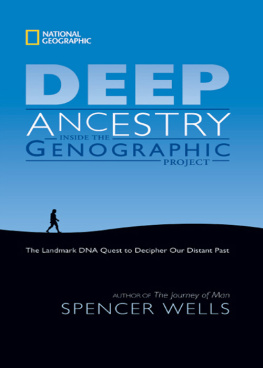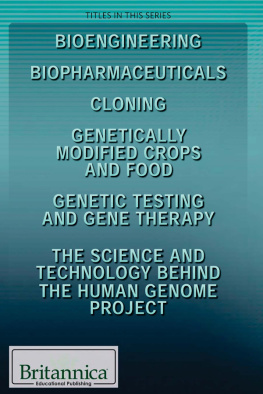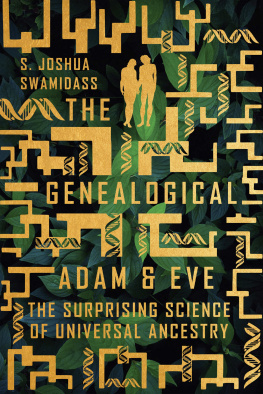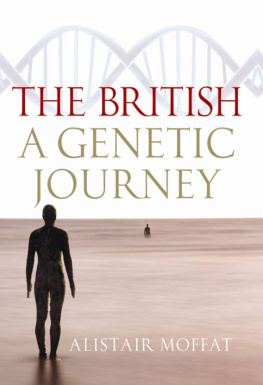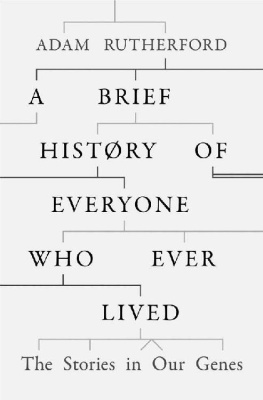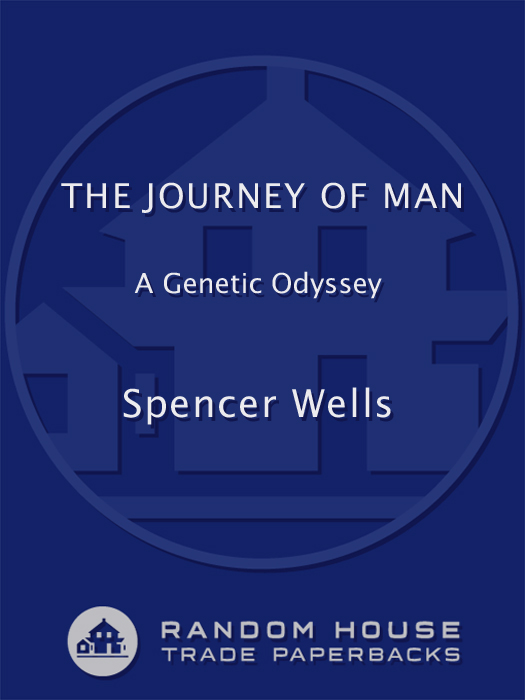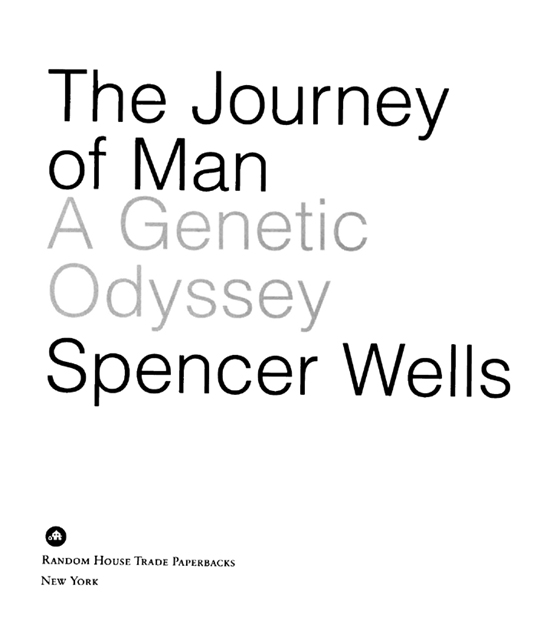2003 Random House Trade Paperback Edition
Copyright 2002 by Spencer Wells
All rights reserved under International and Pan-American Copyright Conventions. Published in the United States by Random House Trade Paperbacks, an imprint of The Random House Publishing Group, a division of Random House, Inc., New York, and simultaneously in Canada by Random House of Canada Limited, Toronto.
R ANDOM H OUSE T RADE P APERBACKS and colophon are trademarks of Random House, Inc.
This work was originally published in hardcover in 2002 by Princeton University Press in the United States and Canada and by Penguin Group in the United Kingdom and European Union.
The author and publisher are grateful to the following for permission to reproduce extracts:
The Songlines by Bruce Chatwin, published by Jonathan Cape, used by permission of The Random House Group Limited;
Buffalo Soldier by Bob Marley, reproduced by permission of Music Sales Limited and EMI Music Publishing;
Little Gidding, Four Quartets, by T. S. Eliot, reproduced by permission of Faber & Faber Ltd.
Library of Congress Cataloging-in-Publication Data
Wells, Spencer
The journey of man: a genetic odyssey / Spencer Wells.
p. cm.
Originally published: Princeton, N.J.: Princeton University Press, 2002.
Includes bibliographical references.
eISBN: 978-0-307-83045-6
1. Human evolution. 2. Human genetics. 3. Human population genetics. I. Title.
GN281.W44 2004 599.938dc22 2003066679
Random House website address: www.atrandom.com
v3.1
Praise for
The Journey of Man
[Wells] navigates gracefully from his home waters of genetics into paleontology and climatology and back again.
The New York Times Book Review
The Journey of Man is the best account available of the story of human origins and dispersals, based on the newly emerging discipline of archaeo-genetics. Wells has himself contributed to some of the work discussed, and so writes with authority about the molecular genetics, and he succeeds well in establishing the broader intellectual context in which the work is situated, so that the book carries more conviction than the good overviews by science writers and journalists that are becoming available.
The Times Higher Education Supplement (London)
In this companion to a PBS special, Wells, a geneticist formerly associated with Oxford University, offers a worthy addition to the field of DNA analysis. In addition to relating the always interesting story of humankinds spread from Africa into the far corners of the world, the author attempts to answer some of the big questions that have concerned paleoanthropology. Fortunately for the lay reader, Wells has a knack for clear descriptions and clever analogies to help explain the intricacies of the science involved. Both entertaining and enlightening, this book is a good addition to popular science collections.
Library Journal
The Journey of Man is packed with important insights into our history and our relationship with each other. [It] is fascinating and oozes charm. Who needs literature when science is this much fun?
The Guardian
[An] engaging primer of the field of population genetics. In Mr. Wells detailed but clear prose, the story of us all is slowly, logically revealed. Mr. Wells often succeeds in transforming complicated scientific conclusions into vivid and insightful analogies. The Journey of Man encourages the reader to ponder the state of humanity today.
The Dallas Morning News
The aim of science is not to open the door to infinite wisdom, but to set a limit to infinite error.
Bertolt Brecht, Life of Galileo
Contents
Maps
Figures
Preface
Most of us can name our grandparents, many our great-grandparents, and some our great-great-grandparents. Beyond that, we enter a dark and mysterious realm known as history, through which we can only navigate with hesitant steps, feeling our way with whispered guidance. Who were the people that came before? Where did they live? What were their lives like?
In this book I will argue that the answers to these questions can be found in our genetic code, which makes us uniquely human but also makes us unique individuals. Our DNA carries, hidden in its string of four simple letters, a historical document stretching back to the origin of life and the first self-replicating molecules, through our amoebic ancestors, and down to the present day. We are the end result of over a billion years of evolutionary tinkering, and our genes carry the seams and spot-welds that reveal the story.
It is not the code itself that delivers the message, but rather the differences we see when we compare DNA from two or more individuals. These differences are the historical language of the genes. In the same way that you wouldnt include water-dwelling in a classification of fish, because all fish live in water, the identical bits of our genetic code tell us nothing about our history. The story is in the differences, and this is what we study.
This is not a book on human origins. Rather, it is about the journey we have taken as a species, from our birthplace in Africa to the far corners of the earth, and from the earliest evidence of fully modern humans to the present day and beyond. The argument pursued throughout is that genetics provides us with a map of our wanderings and gives us a rough idea of the dates and it is up to us to reconcile this data with the archaeological and climatological record in order to fill in the picture. Of course, every journey must have a beginning, and this one is no exception. It begins with the scientific effort to make sense of human diversity, which leads us to the birthplace of our species. The methods we use to infer our African origins are the same ones we then use to trace humanitys global journey. It is the journey itself that is the main focus, and for this reason most of the details of our hominid ancestors have been left out.
This book was originally conceived as part of a documentary film project of the same name. It has since taken on a life of its own, and it stands alone as a unique entity, providing greater detail on the scientific background than is possible on television. The film, on the other hand, presents an (almost) first-hand experience, conveying the excitement and adventure of the journey in a way that only moving images can, so I hope that readers of this book will enjoy it equally.
Although it was often difficult to juggle the film and the book at the same time, this did provide some significant advantages. For me, the chance to retrace my own personal journey of man and to meet people from around the world to see how they live and to discuss the scientific results with them were profound and wonderful experiences. I hope that a sense of this has come through in print.
The title was chosen for a reason and it wasnt sexism. The journey we trace is primarily one made by men, because it is the Y-chromosome, inherited from Adam down the male line, which gives us our keenest tool for deciphering the journey. The Y helps to place the stones, bones and languages in context better than any other part of our genetic code, and ultimately gives us the genetic answers we are looking for. Of course, in order to leave descendants, these early human groups must have included women; while the journey we follow may leave out some female-specific details, the resolution we can achieve only by following the male lineage is worth the omission.


